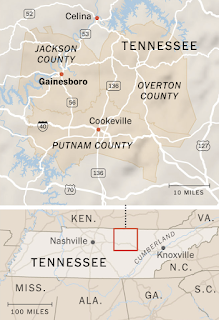 |
| Chart by The Economist |
By Al CrossDirector and Professor, Institute for Rural Journalism and Community Issues, University of Kentucky
The conventional wisdom about hedge funds and other private-equity companies buying newspapers is that they're bad for journalism. But might they also be good for papers, by keeping them afloat?
So argues some research in progress at the California Institute of Technology and New York University, and reported by The Economist, which states flatly, "Private equity is keeping newspapers in business." That's based on the researchers' analysis of papers that have been bought by private-equity firms compared with those that were not. "They found that newspapers that were bought were 75% less likely to shut down. Daily papers were also 60% less likely to become weekly publications."
The paper is still in progress, so it's not published, much less finished with the peer-review process of an academic journal. The researchers and reviewers might want to consider other reasons that papers bought with private equity would be less likely to close, such as a stronger cash flow, which made them more attractive than weaker papers to private equity. As for conversion to weekly, there could be a similar reason, that the papers in smaller markets are less attractive to private equity.
The authors should have considered those factors, said Northwestern University Visiting Professor Penny Abernathy, who has done the most comprehensive studies of newspaper ownership and trends. She told me in an email that there's also a question about the definition of a newspaper: "Is it a stand-alone newspaper, or has it been merged with another newspaper and become merely a zoned edition of another paper? Both Alden [Global Capital] and Gatehouse have extensively merged smaller newspapers with one another and with a larger paper. As a result, when we do our annual survey, we often find between two, three or even more newspapers published under separate banners, but carrying identical 'local' news stories – even though they may be located miles apart or in different counties."
Also, what is private equity? "Are they including the large private regional chains (
Adams, Paxton, Ogden, Hearst), as well as the large national chains (Gatehouse, Alden,
Civitas, CNHI)? The large national chains have a very different focus and management philosophy. As I have pointed out in all my reports, dating back to 2016, the family-owned chains tend to have journalistic roots and mission (balanced with shareholder return), whereas the large national chains are solely focused on shareholder return. The large private regional family-owned chains tend to have tended to have many fewer closures." For Abernathy's full email,
click here.
The Economist reports, "The authors caution that they cannot estimate the general causal effect of private-equity buy-outs, but only the effect on the newspapers in their sample. Private-equity firms do not purchase newspapers randomly. They target failing newsrooms with potential for turnaround; papers with low circulation but high advertising rates were more likely to be bought, they found."
What seems more certain is that the researchers have latched onto a very worthwhile topic and are rendering some useful facts, as described by The Economist: "After private-equity buy-outs, papers laid off reporters and editors. Across a sample of 766 American newspapers (accounting for around 45% of total circulation), the researchers found that payrolls were about 7% lower at papers with new private-equity capital than if they had not been bought out. They also found a 16.7% relative decline in the number of articles written within five years of the buy-outs (though, admittedly, that is better than going out of business). And they identified a change in focus from local to national news: the share of articles on local politics dropped by about a tenth."
So, private equity appears to be bad for local journalism, which is in trouble not just because newspapers are in trouble but because Americans have become less interested in local news and more interested in national news in the era of social media that make geography less meaningful, and at a time where the intensity of national politics is having
deleterious effects at the local level.
"Local reporting is expensive, because it requires journalists on the ground and cannot be syndicated," The Economist notes. "In a study published last year, researchers at
Colorado State University, Louisiana State University and
Texas A&M University concluded that when readers consume national news their views become more polarized. Poor local coverage is also associated with less competitive mayoral elections, and newsroom staff shortages are linked to lower voter turnout."














